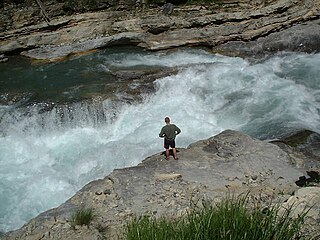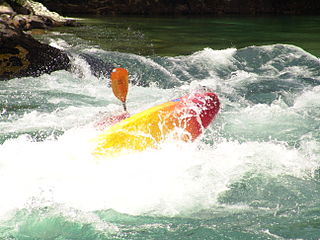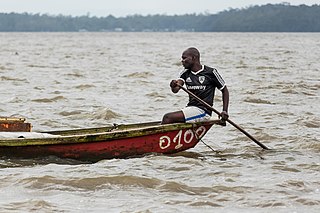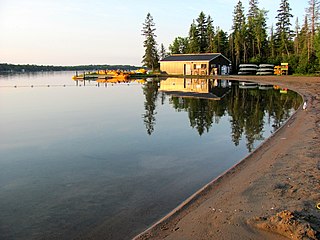
A boat is a watercraft of a large range of types and sizes, but generally smaller than a ship, which is distinguished by its larger size, shape, cargo or passenger capacity, or its ability to carry boats.

A kayak is a small, narrow watercraft which is typically propelled by means of a double-bladed paddle. The word kayak originates from the Greenlandic word qajaq.

A paddle is a handheld tool with an elongated handle and a flat, widened distal end, used as a lever to apply force onto the bladed end. It most commonly describes a completely handheld tool used to propel a human-powered watercraft by pushing water in a direction opposite to the direction of travel. It is different to an oar in that the latter is attached to the watercraft via a fulcrum.

Whitewater forms in a rapid context, in particular, when a river's gradient changes enough to generate so much turbulence that air is trapped within the water. This forms an unstable current that froths, making the water appear opaque and white.

Any vehicle used in or on water as well as underwater, including boats, ships, hovercraft and submarines, is a watercraft, also known as a water vessel or waterborne vessel. A watercraft usually has a propulsive capability and hence is distinct from a stationary device, such as a pontoon, that merely floats.

Whitewater kayaking is an adventure sport where a river is navigated in a decked kayak. Whitewater kayaking includes several styles. River running; where the paddler follows a river and paddles rapids as they travel. Creeking usually involving smaller, steeper, and more technical waterways. Creek boats tend to be short but high volume to allow for manoeuvrability while maintaining buoyancy. Slalom requires paddlers to navigate through "gates". Slalom is the only whitewater event to be in the Olympics. Play boating involves staying on one feature of the river and is more artistic than the others. Squirt boating uses low-volume boats to perform special moves in whitewater features.

Boating is the leisurely activity of travelling by boat, or the recreational use of a boat whether powerboats, sailboats, or man-powered vessels, focused on the travel itself, as well as sports activities, such as fishing or waterskiing. It is a popular activity, and there are millions of boaters worldwide.
The Massive Murray Paddle, formerly the Red Cross Murray Marathon or Murray Marathon, and later the YMCA Massive Murray Paddle, is an Australian 404 km, 5-day canoe/kayak flatwater race on the Murray River. One of the longest annual flatwater canoe races in the world, it starts in Yarrawonga and ends in Swan Hill. The race raises funds to assist local community-driven programs.

Canoe diving and Kayak diving are recreational diving where the divers paddle to a diving site in a canoe or kayak carrying all their gear in or on the boat to the place they want to dive. Canoe or kayak diving gives the diver independence from dive boat operators, while allowing dives at sites which are too far to comfortably swim, but are sufficiently sheltered.

Paddling with regard to watercraft is the act of manually propelling a boat using a paddle. The paddle, which consists of one or two blades joined to a shaft, is also used to steer the vessel. The paddle is not connected to the boat.

Balsam Lake Provincial Park is a provincial park located in south-central Ontario on Balsam Lake. The park is situated along the Trent-Severn Waterway, a few kilometres southwest of Coboconk. It is an all-seasons recreation area offering camping, boating and fishing, and while closed in winter it is also used for skiing and snowshoeing.

The following outline is provided as an overview of canoeing and kayaking:

Human-powered watercraft are watercraft propelled by human power.
The Recreational Craft Directive, Directive 2013/53/EU, originally Directive 94/25/EC on recreational craft amended by Directive 2003/44/EC, is a European Union directive which sets out minimum technical, safety and environmental standards for boats, personal watercraft, marine engines and components in Europe. It covers boats between 2.5 and 24m, personal watercraft, engines and a number of components built since 1998. It ensures their suitability for sale and use in Europe.

A boat livery is a boathouse or dock on a lake or other body of water, where boats are let out for hire (rental), usually on an hourly, daily or weekly basis. Boats may be powered or sail craft or human powered like rowboats, paddleboats (pedalos) or inflatable boats. The primary use of the boats is recreational.
Confluence Outdoor is an American manufacturer of kayaks, canoes, and related accessories. The company comprises eight separate brands which each specialize in paddling sport boats or accessories.
Scuba diving tourism is the industry based on servicing the requirements of recreational divers at destinations other than where they live. It includes aspects of training, equipment sales, rental and service, guided experiences and environmental tourism.















